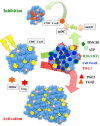Harnessing radiation to improve immunotherapy: better with particles?
- PMID: 31317768
- PMCID: PMC7066943
- DOI: 10.1259/bjr.20190224
Harnessing radiation to improve immunotherapy: better with particles?
Abstract
The combination of radiotherapy and immunotherapy is one of the most promising strategies for cancer treatment. Recent clinical results support the pre-clinical experiments pointing to a benefit for the combined treatment in metastatic patients. Charged particle therapy (using protons or heavier ions) is considered one of the most advanced radiotherapy techniques, but its cost remains higher than conventional X-ray therapy. The most important question to be addressed to justify a more widespread use of particle therapy is whether they can be more effective than X-rays in combination with immunotherapy. Protons and heavy ions have physical advantages compared to X-rays that lead to a reduced damage to the immune cells, that are required for an effective immune response. Moreover, densely ionizing radiation may have biological advantages, due to different cell death pathways and release of cytokine mediators of inflammation. We will discuss results in esophageal cancer patients showing that charged particles can reduce the damage to blood lymphocytes compared to X-rays, and preliminary in vitro studies pointing to an increased release of immune-stimulating cytokines after heavy ion exposure. Pre-clinical and clinical studies are ongoing to test these hypotheses.
Figures





References
MeSH terms
Substances
LinkOut - more resources
Full Text Sources
Medical

